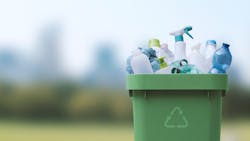A coalition of researchers led by the U.S. Department of Energy’s National Renewable Energy Laboratory (NREL), Golden, Colo., has developed a proof of concept for combining chemical and biological processes into a method that could expand the range of recyclable plastics by avoiding the need to sort plastics by type. Scientists from Oregon State University (OSU), Massachusetts Institute of Technology, the University of Wisconsin-Madison and Oak Ridge National Laboratory also took part in the study.
“Our work has resulted in a process that can convert mixed plastics to a single chemical product,” says Lucas Ellis, an assistant professor of chemical engineering at OSU in Corvallis, Ore.
A recent article in Science explains how the researchers applied the method to a mix of three common plastics: polystyrene, polyethylene terephthalate, and high-density polyethylene.
First, an oxidation process broke down the plastics into a mixture of compounds including benzoic acid, terephthalic acid and dicarboxylic acids. The researchers then engineered a soil microbe, Pseudomonas putida, to biologically transform the mixture into one of two products — polyhydroxyalkanoates, which are biodegradable plastics, and beta-ketoadipate, a component in performance-advantaged nylon.
The researchers next plan to try the process with other types of plastics including polypropylene and polyvinyl chloride.
“The chemical catalysis process we have used is just a way of accelerating a process that occurs naturally, so instead of degrading over several hundred years, you can break down these plastics in hours or minutes,” notes Kevin Sullivan, a postdoctoral researcher at NREL.
The robustness of the catalyst will require more investigation. Ellis explains: “The system of catalysts we used included a free-radical initiator, called N-hydroxyphthalimide (NHPI), along with several metal cations known to help guide reaction selectivity in oxidation chemistry. This combination is used commercially in the production of terephthalic acid from xylenes, thus is a proven industrial chemistry and quite robust. However, the commercial system uses a bromine-based free-radical initiator. Bromine (Br), in these reaction conditions, is extremely corrosive and, depending on the final form, can be a germicide. We opted for a less-corrosive catalyst system, using NHPI. It is less robust but much more biologically friendly (less toxic) than Br. It is very possible there could be a process developed around using a Br-based free-radical initiator.”
Contaminants found in mixed plastic wastes often plague other catalytic systems, but Ellis doesn’t suspect this is an issue.
“Most plastics have additives like free-radical scavengers or dyes, which can be a problem for some catalytic systems. … Depending on the quantity and identity of free-radical scavengers found in mixed-plastic waste, there would be some change in activity of our catalyst system. However, these additives would likely reduce the efficacy of oxidation reactions with plastics stoichiometrically; in other words, if we provided more NHPI the chemistry would proceed. (Again, we could explore other free-radical initiators as well.)”
The team acknowledges opportunities exist to further improve integration of the catalytic and biological steps.
“One unique aspect of our proposed concept is the need to synergize the chemical processing system and the biological system. For example, the chemical process cannot produce (or must minimize) chemicals toxic to biology, this includes solvents, catalysts, and reaction byproducts. Thus, the bridge between the chemical and biological process will be extremely important for overall process economics and final product yields. One could imagine two different extremes for unit operations between chemistry and biology (with a wide array of options in between): 1) have minimal separations (likely cheaper) and feed the non-purified effluent from the chemical reactor to the biological system or 2) highly purify the products from reaction to feed the perfect feedstock to biology. … We believe there are opportunities to incorporate low-operating-cost separations in-between these unit operations, to not only maximize product value, but also minimize cost,” explains Ellis. For example, he adds, incorporating specialized separation unit operations to extract potentially high-value reaction products from the chemical process before feeding to biology.
“We saw this project as demonstrating what is possible when you combine the advantages of chemistry and biology to upcycling mixed waste plastic into a biopolymer or a precursor to advantaged nylon. This is the first step toward many different avenues to upcycle plastic, such as developing novel metabolic pathways to funnel the carbon to a different product; refining the catalyst system to maximize product yield from a mixture of plastics at the same processing conditions (our work demonstrated the ideal reaction conditions were not the same for each polymer); incorporating separation unit operations to minimize operating costs; or others. There is a wide array of directions this work (or the field more broadly) could pursue,” suggests Ellis.
About the Author
Chemical Processing Staff
Chemical Processing's editors cover industry news relevant to readers. You can email your news items to Editor-in-Chief Traci Purdum at [email protected].
